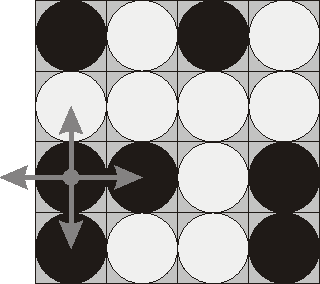Description
Flip game is played on a rectangular 4x4 field with two-sided pieces placed on each of its 16 squares. One side of each piece is white and the other one is black and each piece is lying either it's black or white side up. Each round you flip 3 to 5 pieces,
thus changing the color of their upper side from black to white and vice versa. The pieces to be flipped are chosen every round according to the following rules:
 Consider the following position as an example:
Consider the following position as an example:
bwbw
wwww
bbwb
bwwb
Here "b" denotes pieces lying their black side up and "w" denotes pieces lying their white side up. If we choose to flip the 1st piece from the 3rd row (this choice is shown at the picture), then the field will become:
bwbw
bwww
wwwb
wwwb
The goal of the game is to flip either all pieces white side up or all pieces black side up. You are to write a program that will search for the minimum number of rounds needed to achieve this goal.
- Choose any one of the 16 pieces.
- Flip the chosen piece and also all adjacent pieces to the left, to the right, to the top, and to the bottom of the chosen piece (if there are any).
 Consider the following position as an example:
Consider the following position as an example: bwbw
wwww
bbwb
bwwb
Here "b" denotes pieces lying their black side up and "w" denotes pieces lying their white side up. If we choose to flip the 1st piece from the 3rd row (this choice is shown at the picture), then the field will become:
bwbw
bwww
wwwb
wwwb
The goal of the game is to flip either all pieces white side up or all pieces black side up. You are to write a program that will search for the minimum number of rounds needed to achieve this goal.
Input
The input consists of 4 lines with 4 characters "w" or "b" each that denote game field position.
Output
Write to the output file a single integer number - the minimum number of rounds needed to achieve the goal of the game from the given position. If the goal is initially achieved, then write 0. If it's impossible to achieve the goal, then write the word "Impossible"
(without quotes).
Sample Input
bwwb bbwb bwwb bwww
Sample Output
4
这题看了别人的思路,自己写出来了。首先要想清楚一点,就是如果可以翻成功的话,最多只要16次,即每个点都翻一次,因为对于每一个点,翻动两次和没有翻该点及周围4个点状况是一样的(可以画下图),所以只需考虑16步,依次从1累加到16,看能不能使得图中每个点都为'b'或者都为'w',图总共有2^16次不同形态。这道题学到一点,就是二维数组做函数参数的时候,不能写成void f(s[][]),第二维一定要有大小,如void f(s[][10]),或者直接写成void f(s[6][10])。
#include<stdio.h>
#include<string.h>
char s[6][10];
int flag,step;
int tab[10][2]={{0,0},{0,1},{-1,0},{0,-1},{1,0}};
int panduan(char s[6][10]){
int i,j;
char c=s[0][0];
for(i=0;i<4;i++){
for(j=0;j<4;j++){
if(s[i][j]!=c)
return 0;
}
}
return 1;
}
void flip(int row,int col)
{
int i,j,xx,yy;
if(s[row][col]=='w') s[row][col]='b';
else s[row][col]='w';
for(i=1;i<=4;i++){
xx=row+tab[i][0];
yy=col+tab[i][1];
if(xx>=0 && xx<=3 && yy>=0 && yy<=3){
if(s[xx][yy]=='w')s[xx][yy]='b';
else s[xx][yy]='w';
}
}
}
void dfs(int row,int col,int dep)
{
int i,j;
if(dep==step){
flag=panduan(s);
return;
}
if(flag || row==4)return;
flip(row,col);
if(col<3){
dfs(row,col+1,dep+1); //这里翻点是一行一行翻的
}
else dfs(row+1,0,dep+1);//如果当前列数已经是最大了,那么就翻下一行,且列数重新变为0
if(flag)return;
flip(row,col); //如果翻这一个点不能成功的话就翻回这个点,但注意只是这个点,而不是把翻这个点后面所形成的所有情况都清除,我在这里想了很久。
if(col<3){
dfs(row,col+1,dep);//这里因为这个点(row,col)不翻动,所以还是当前步数还是dep
}
else dfs(row+1,0,dep);
return;
}
int main()
{
int n,m,i,j;
while(scanf("%s",s[0])!=EOF)
{
for(i=1;i<4;i++){
scanf("%s",s[i]);
}
if(panduan(s)){
printf("0
");continue;
}
for(step=1;step<=16;step++){
flag=0;
dfs(0,0,0);
if(flag)break;
}
if(flag){
printf("%d
",step);
}
else printf("Impossible
");
}
return 0;
}